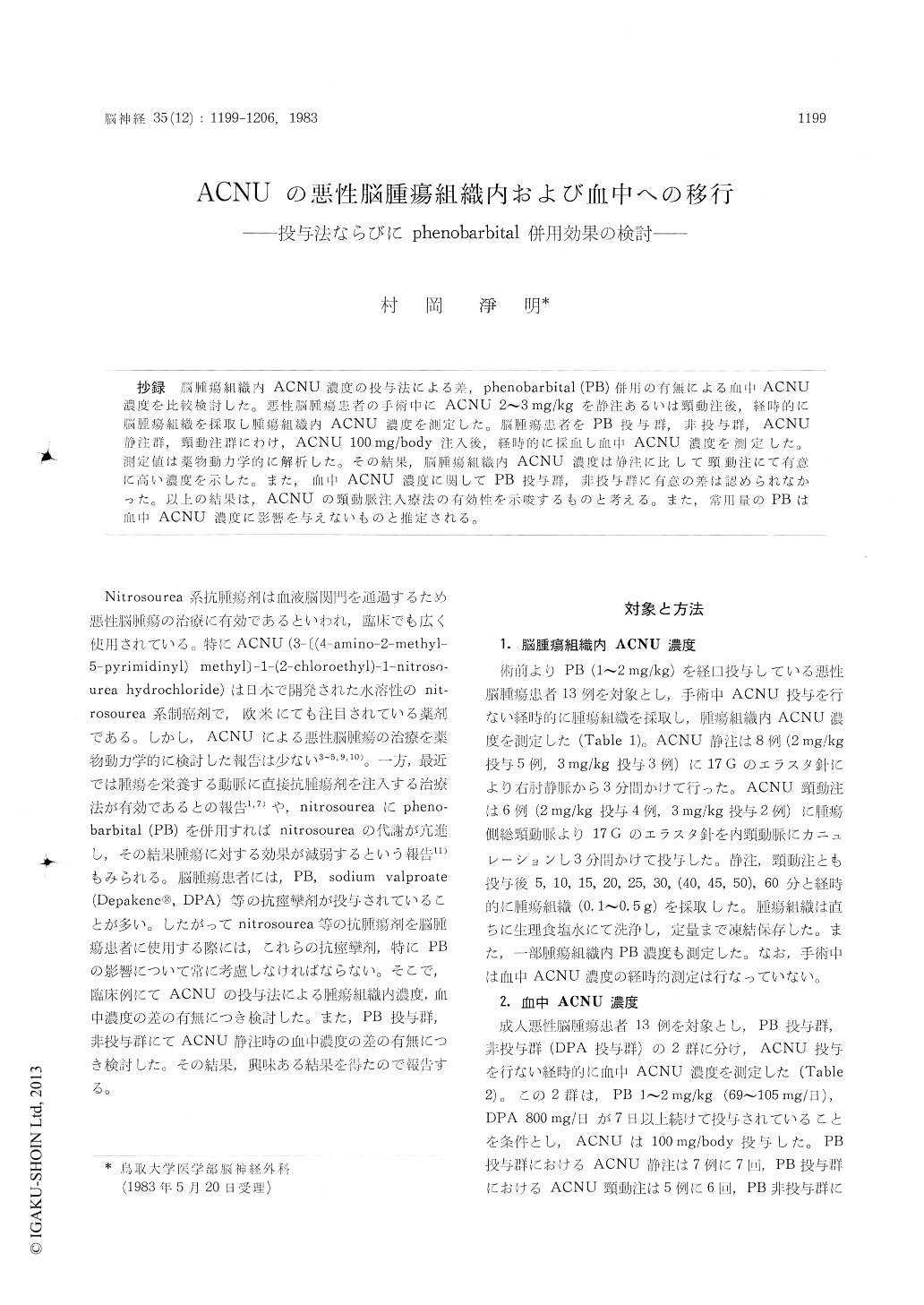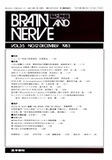Japanese
English
- 有料閲覧
- Abstract 文献概要
- 1ページ目 Look Inside
抄録 脳腫瘍組織内ACNU濃度の投与法による差,phenobarbital (PB)併用の有無にょる血中ACNU濃度を比較検討した。悪性脳腫瘍患者の手術中にACNU 2〜3 mg/kgを静注あるいは頸動注後,経時的に脳腫瘍組織を採取し腫瘍組織内ACNU濃度を測定した。脳腫瘍患者をPB投与群,非投与群,ACNU静注群,頸動注群にわけ,ACNU 100 mg/body注入後,経時的に採血し血中ACNU濃度を測定した。測定値は薬物動力学的に解析した。その結果,脳腫瘍組織内ACNU濃度は静注に比して頸動注にて有意に高い濃度を示した。また,血中ACNU濃度に関してPB投与群,非投与群に有意の差は認められなかった。以上の結果は,ACNUの頸動脈注入療法の有効性を示唆するものと考える。また,常用量のPBは血中ACNU濃度に影響を与えないものと推定される。
Since nitrosourea compounds as chemotherapeu-tic agent can cross the blood brain barrier, they are widely used in the treatment of malignant brain tumors.
ACNU (3-[(4-amino-2-methyl-5-pyrimidinyl) methyl] -1-(2-chloroethyl)-1-nitrosourea hydro-chloride) has become a popular agent, as it is water-soluble and has shown potent effectiveness for treating gliomas. Only a few studies have ever been reported concerning the pharmacokinetics of ACNU in human brain tumors. Intra-arterial administration of chemotherapeutic agents has recently been paid special attention, because it is expected to be more effective than intravenous administration.
On the other hand, phenobarbital as an anticon-vulsant, widely used in clinical management of malignant brain tumor patients has been reported to reduce the toxicity of nitrosourea compounds by induction of hepatic microsomal enzyme rela-ting to their metabolism. In this report, malignant brain tumor patients were divided into two groups ; ACNU was administered either by internal caro-tid or intravenous route.
ACNU concentrations in blood or tumor tissue following the administration were serially com-pared between these two groups. Patients were also divided into another two groups ; ACNU was administered in combination with or without phe-nobarbital. Between these two groups, ACNU in concentrations in blood were serially compared in order to detect the influence of phenobarbital.
ACNU concentrations in tumor tissues were measured at 5, 10, 15, 20, 25, 30, (40, 45, 50), 60 minutes after intravenous (IV) or internal ca-rotid arterial (ICA) administration of ACNU (2-3 mg/kg). Maximum ACNU levels in tumor tissue following IV and ICA injection was observed at 10 min. after administration in every case. The mean maximum concentrations of ACNU was 2.7 μg/g following IV administration and 4.5 μg/g following ICA administration.
ACNU concentations in tumor tissue following ICA administration were higher than those fol-lowing IV injection. In three cases, ACNU remain-ed to be detected in tumor tissue for long time following the IV or ICA administration. In a case of astrocytoma (Grade III), 0.02-0.21 μg/g of ACNU was detected at 4 days after IV administ-ration (100 mg). In the second case of malignant meningioma, 0.06 μg/g of ACNU could be measur-ed at 8 days after ICA injection (100 mg). In thethird case of astrocytoma (Grade III), 2.31 μg/g of ACNU could be found at 14 days after ICA injection (150 mg). ACNU could not be detected in blood of any case at the same time of measu-rement. These results suggested that ACNU could exert long term-tumoricidal effect in brain tumor tissue.
No definite differences could, however, be obtain-ed concerning the effect of phenobarbital to the ACNU level in blood between the two groups with or without phenobarbital. From these results, it can be safely concluded that internal carotidarterial administration of ACNU is more effective than intravenous administration in terms of ACNU level in tumor tissue, and when it was used with phenobarbital side effects will be reduced.
From pharmacokinetic point of view, it is con-cluded that the administration of ACNU via inter-nal carotid artery might be more effective than intravenous injection. Further studies will be re-quired whether the side effects of ACNU could be reduced by the concomitant use of phenobar-bital.

Copyright © 1983, Igaku-Shoin Ltd. All rights reserved.


